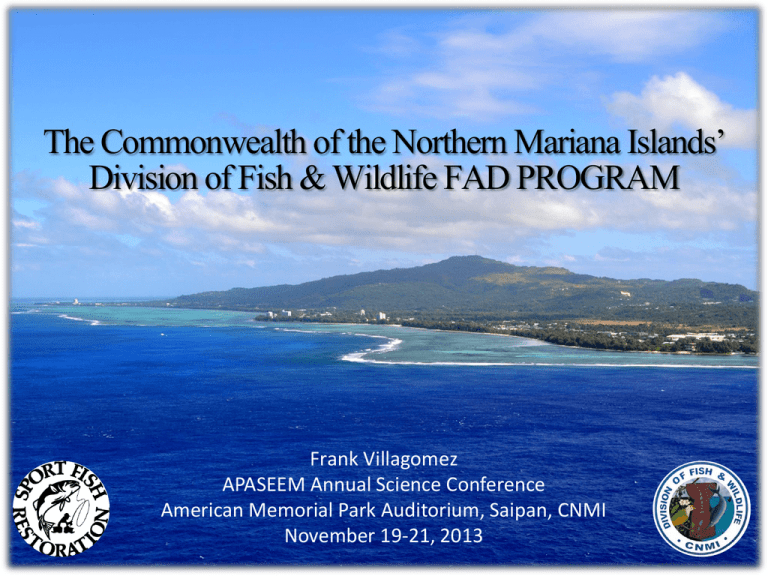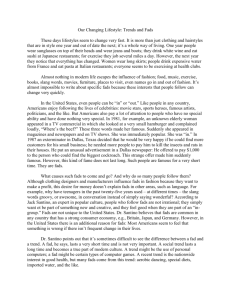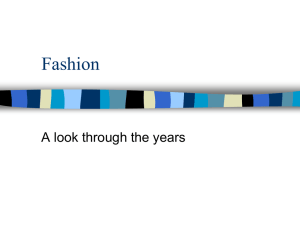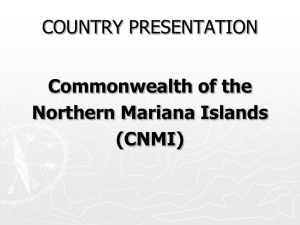CNMI DFW, FAD PROGRAM - CNMI`s Division of Fish and Wildlife
advertisement

The Commonwealth of the Northern Mariana Islands’ Division of Fish & Wildlife FAD PROGRAM Frank Villagomez APASEEM Annual Science Conference American Memorial Park Auditorium, Saipan, CNMI November 19-21, 2013 Brief Overview •CNMI FAD Program •What are FADs? •FAD History •CNMI FADs •How do they work? •Pelagic Fisheries •Pros & Cons •Issues and Future of FAD Program Purpose of FAD Program To promote pelagic recreational fishing by providing fishermen with a cost effective way of catching pelagic fish in the CNMI. Also to promote pelagic recreational fishing. What are FADs? Fish Aggregating Devices or FADs are generally floating logs or other drifting objects that attract fish around them FAD HISTORY In the early 1900s, fishermen in Indonesia and the Philippines began building floating rafts of bamboo and other materials to attract schools of fish (Anderson & Gates 1996) Modern Fish Aggregating Devices are derived from traditional Filipino aggregating system called the Payao. FAD HISTORY Modifications were made to enable FADS to withstand the forces of the open ocean. Monofilament lines Fiber glass buoys Chains Lighting Other modifications were developed to enhance the productivity of FADS. FADs in the CNMI The Pacific Tuna Development Foundation Deployed 5 FADs at leeward side in the spring of 1980 3-drum NMFS design 2 near Saipan 2 near Tinian 1 near Rota FADs in the CNMI All lost within 2 - 5 months 1-drum design after loss FADs in the CNMI Location of FADs 10 FAD sites 5 to 10 miles from shore Between 1,000 to 6,000 feet of depth 6 active FADs near Saipan and Tinian Redeploy FADs to replace inactive sites this fiscal year FAD Mooring System How do FAD Systems Work? Provides a substrate for algae and barnacles to attach to The fouling of the FAD system creates an artificial habitat for small fish. The small fish attract larger fish such as Skipjack tuna, Mahi-mahi, Wahoo and Marlin. These fish can then be caught at a fixed location. Which means less fuel spent searching for bird flocks. COMMON FISH FOUND AROUND FADS CNMI Creel Survey 2011 Pelagic Species Composition 3% 1% 0% 2% 2% Total Landings % 0% Skipjack Tuna 12% Mahimahi Yellowfin Tuna 16% 64% Wahoo Rainbow Runner Are fish all at the top? Deployment of FADs Video BENEFITS OF FADS A SET LOCATION FOR TROLL FISHING HIGHER PROBABILITY OF CATCHING A FISH VERY ECONOMICAL FOR FISHERMEN LESS TIME SPENT ON SEARCHING FOR SCHOOLS OF FISH SAFETY FOR SMALL BOAT FISHERS CONS OF FADS HIGH LOSS RATE 2 to 4 units are lost within the first year. HIGH UNIT COST Average cost per unit is $7000. SHORT LIFE SPAN 1 to 2 years Issues, problems, and concerns Dependence on imported materials contributes to the high cost of services and products. The construction of FADs requires materials that are not readily available in the CNMI. The CNMI has few vendors who are able to offer services for the procurement of FAD materials. Deployment costs continue to increase each year. Companies who are familiar with the deployment process increased their prices. In contrast newer companies who aren’t familiar with the deployment process bid low which can force the program to award the cheaper, unskilled company; in the past this resulted in a few lost FADs. Future prospects To possibly help alleviate the increased costs of deployment, the FRS will continue to research for new buoy designs for prolonged lifespan of FAD systems To possibly help increase the productivity of a FAD, coconut fronds will be investigated and implemented as additional aggregators The use of a towed-barge for FAD deployments is currently being investigated to alleviate increasing deployment costs For more information on FADs contact Frank Villagomez Office: (670) 664-6044 Email: fvillagomez.dfw@gmail.com











